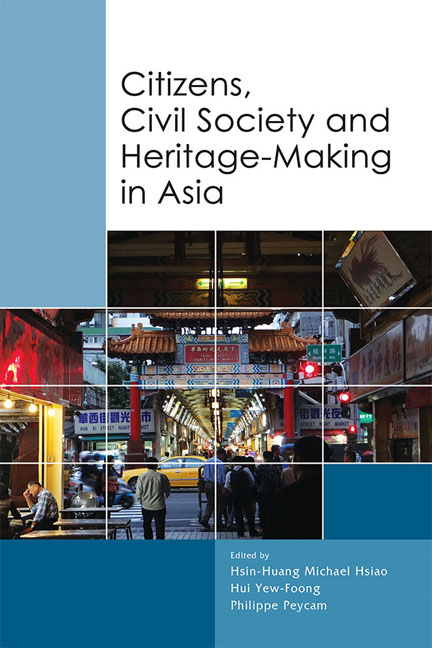Book contents
- Frontmatter
- Contents
- Contributors
- 1 Introduction: Finding the Grain of Heritage Politics
- 2 Heritage, Identity and Power
- 3 Heritage-Making and Post-coloniality in Yangon, Myanmar
- 4 Living Heritage of Ruins? Contesting the Paradox in Trowulan's Majapahit Heritage
- 5 The Reconstruction of Heritage in Rural Vietnam: An Analysis of State and Local Dynamics
- 6 Performing Cultures, Negotiating Identities: The Cultural Politics of Indigenous Cultural Villages in West Malaysia
- 7 Constituting Philippine Filmic and Linguistic Heritage: The Case of Filipino Regional Films
- 8 Encounter and Counter-Narratives of Heritage in Macau
- 9 Cultural Activities of the Chinese Community in Post-war Myanmar
- 10 Chinese Street Opera in Singapore: Heritage or a Vanishing Trade
- 11 Policy Formation and Civil Society Engagement in Heritage-Making in Taiwan: A Historical Examination
- 12 Becoming Taiwanese: Appropriation of Japanese Colonial Sites and Structures in Cultural Heritage-Making — A Case Study on the Wushantou Reservoir and Hatta Yoichi
- 13 Defining Culture in the Heritage Preservation of Taiwanese Veterans’ Villages: The Case of Zuoying
- 14 Tobacco Crop Memories in Taiwan: The Heritage of a Deadly Agriculture
- Index
3 - Heritage-Making and Post-coloniality in Yangon, Myanmar
Published online by Cambridge University Press: 03 January 2018
- Frontmatter
- Contents
- Contributors
- 1 Introduction: Finding the Grain of Heritage Politics
- 2 Heritage, Identity and Power
- 3 Heritage-Making and Post-coloniality in Yangon, Myanmar
- 4 Living Heritage of Ruins? Contesting the Paradox in Trowulan's Majapahit Heritage
- 5 The Reconstruction of Heritage in Rural Vietnam: An Analysis of State and Local Dynamics
- 6 Performing Cultures, Negotiating Identities: The Cultural Politics of Indigenous Cultural Villages in West Malaysia
- 7 Constituting Philippine Filmic and Linguistic Heritage: The Case of Filipino Regional Films
- 8 Encounter and Counter-Narratives of Heritage in Macau
- 9 Cultural Activities of the Chinese Community in Post-war Myanmar
- 10 Chinese Street Opera in Singapore: Heritage or a Vanishing Trade
- 11 Policy Formation and Civil Society Engagement in Heritage-Making in Taiwan: A Historical Examination
- 12 Becoming Taiwanese: Appropriation of Japanese Colonial Sites and Structures in Cultural Heritage-Making — A Case Study on the Wushantou Reservoir and Hatta Yoichi
- 13 Defining Culture in the Heritage Preservation of Taiwanese Veterans’ Villages: The Case of Zuoying
- 14 Tobacco Crop Memories in Taiwan: The Heritage of a Deadly Agriculture
- Index
Summary
In a nation where the post-independence, military-led governments saw their people as potential enemies who threatened the territorial integrity of Myanmar,1 heritage-making has been deployed as an exclusive technique of the state to manufacture a unitary national identity. That identity has been Burman (the dominant ethnic group), Buddhist, and, until recently, staunchly anti-colonial, with the Shwedagon Pagoda standing as its ultimate monument. Since 2012, educated elite in Yangon have begun to rewrite the narrative of colonial oppression to incorporate the modernity implanted through British rule as represented by the grand facades of institutions such as Grindlays Bank and the Secretariat. This foregrounding of aesthetic modernity has been spearheaded by Thant Myint-U (grandson of U Thant, the third UN secretary-general), who has returned to Myanmar from a cosmopolitan life in the West. With the assistance of foreign-educated Myanmar architects, Thant has founded the Yangon Heritage Trust (YHT) to safeguard the physical and aesthetic integrity of colonial-era buildings. In the words of Thant, “If we can make Yangon the most attractive, beautiful and liveable city in Southeast Asia, this is an asset worth billions of dollars” (Linthicum 2014).
This chapter investigates the influence of Myanmar's elite, a small segment of the city's civil society, in redefining Yangon's heritage during a time of unprecedented change. National reforms initiated in 2011 followed by the lifting of international sanctions have ushered in fast-paced real estate development that threatens to alter the face of Yangon before the local population has a chance to reflect on what they value. In the haste to save turn-of-the-century architecture from the irreparable damage of wrecking balls, critical questions about the history of Yangon and how residents live in the city have been left barely examined. The YHT's efforts to save colonial-era buildings, though important for maintaining the traces of history in the built environment, run the risk of erasing colonial abuses and masking entrenched urban inequalities. These inequalities were largely introduced by British rule, even if paradoxes, exclusions and segmentations are always a part of urban organization and city form (AlSayyad and Roy 2006).
- Type
- Chapter
- Information
- Citizens, Civil Society and Heritage-Making in Asia , pp. 40 - 60Publisher: ISEAS–Yusof Ishak InstitutePrint publication year: 2017



